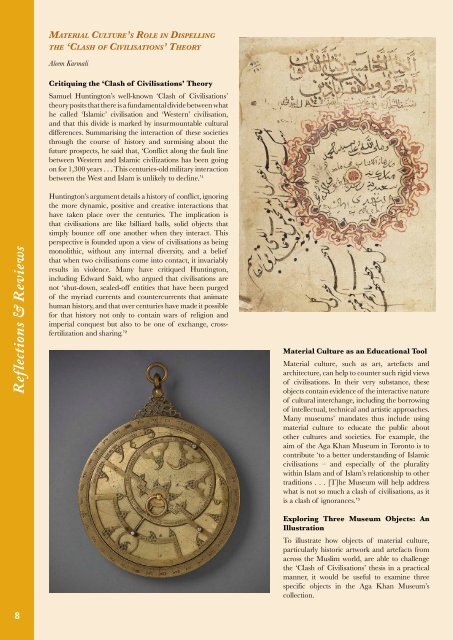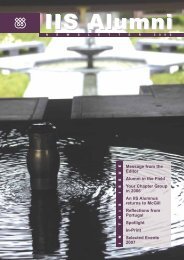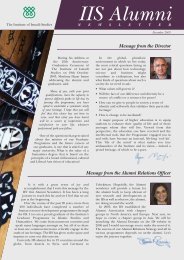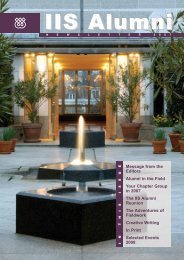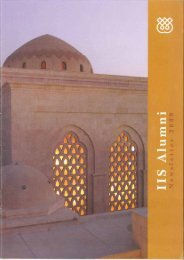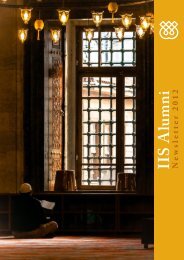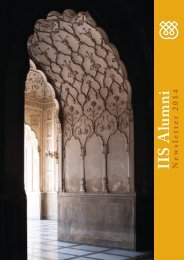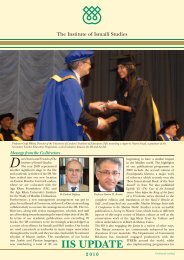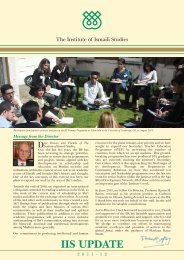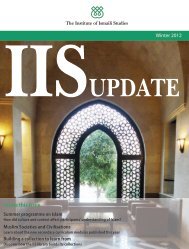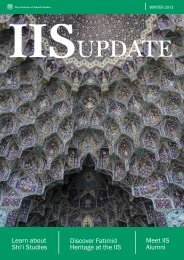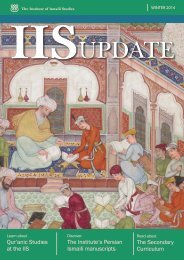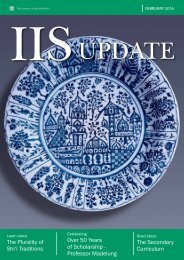IIS Alumni Newsletter 2015
- No tags were found...
You also want an ePaper? Increase the reach of your titles
YUMPU automatically turns print PDFs into web optimized ePapers that Google loves.
Material Culture’s Role in Dispelling<br />
the ‘Clash of Civilisations’ Theory<br />
Aleem Karmali<br />
Reflections & Reviews<br />
8<br />
Critiquing the ‘Clash of Civilisations’ Theory<br />
Samuel Huntington’s well-known ‘Clash of Civilisations’<br />
theory posits that there is a fundamental divide between what<br />
he called ‘Islamic’ civilisation and ‘Western’ civilisation,<br />
and that this divide is marked by insurmountable cultural<br />
differences. Summarising the interaction of these societies<br />
through the course of history and surmising about the<br />
future prospects, he said that, ‘Conflict along the fault line<br />
between Western and Islamic civilizations has been going<br />
on for 1,300 years . . . This centuries-old military interaction<br />
between the West and Islam is unlikely to decline.’¹<br />
Huntington’s argument details a history of conflict, ignoring<br />
the more dynamic, positive and creative interactions that<br />
have taken place over the centuries. The implication is<br />
that civilisations are like billiard balls, solid objects that<br />
simply bounce off one another when they interact. This<br />
perspective is founded upon a view of civilisations as being<br />
monolithic, without any internal diversity, and a belief<br />
that when two civilisations come into contact, it invariably<br />
results in violence. Many have critiqued Huntington,<br />
including Edward Said, who argued that civilisations are<br />
not ‘shut-down, sealed-off entities that have been purged<br />
of the myriad currents and countercurrents that animate<br />
human history, and that over centuries have made it possible<br />
for that history not only to contain wars of religion and<br />
imperial conquest but also to be one of exchange, crossfertilization<br />
and sharing.’²<br />
Material Culture as an Educational Tool<br />
Material culture, such as art, artefacts and<br />
architecture, can help to counter such rigid views<br />
of civilisations. In their very substance, these<br />
objects contain evidence of the interactive nature<br />
of cultural interchange, including the borrowing<br />
of intellectual, technical and artistic approaches.<br />
Many museums’ mandates thus include using<br />
material culture to educate the public about<br />
other cultures and societies. For example, the<br />
aim of the Aga Khan Museum in Toronto is to<br />
contribute ‘to a better understanding of Islamic<br />
civilisations – and especially of the plurality<br />
within Islam and of Islam’s relationship to other<br />
traditions . . . [T]he Museum will help address<br />
what is not so much a clash of civilisations, as it<br />
is a clash of ignorances.’³<br />
Exploring Three Museum Objects: An<br />
Illustration<br />
To illustrate how objects of material culture,<br />
particularly historic artwork and artefacts from<br />
across the Muslim world, are able to challenge<br />
the ‘Clash of Civilisations’ thesis in a practical<br />
manner, it would be useful to examine three<br />
specific objects in the Aga Khan Museum’s<br />
collection.


